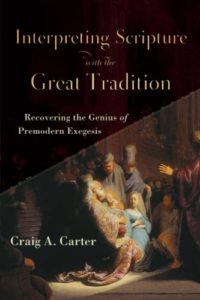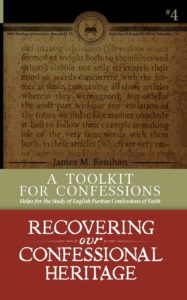
How to Read a Premodern Confession: The Single Meaning of Scripture and the 2LCF 1:9
I have been asked this question numerous times, so I thought I would answer it here and then this can be a reference for the future. A reader asks:
I’m currently reading Interpreting Scripture with the Gread Tradition. Very well done. Have you addressed anywhere how the overall thesis you promote in your book does not contradict the 2LC 1.9 clause “not manifold, but one”? Thank you for your work!
In my book, I nterpreting Scripture with the Great Tradition, I argue for a premodern hermeneutics as superior to the modern approach to hermeneutics, including both the historical-critical and the grammatical-historical approaches. Specifically, I argue that the primary meaning of a biblical text is the Divine authorial intent. The human authorial intent is inspired by God and so it is true so far as it goes. But as 1 Peter 1:10-12 clearly states, the Old Testament human authors did not fully understand the meaning of what they themselves were inspired to write. They had a partial understanding, as did their first readers in their own day. It was not gibberish, but it was incomplete. When the prophecies were fulfilled in Jesus Christ, the deeper Divine intention (which had been there all along) was comprehended by those readers. Hence, Paul says that “these things” (i.e. the Hebrew Scriptures) “were written for our instruction, on whom the end of the ages has come.” (1 Cor. 10:11) Peter is speaking about the prophets and Paul is speaking about the Torah in 1 Cor. 10. In Luke 24 Jesus tells the two disciples on the Road to Emmaus that the both the Law and the Prophets speak of him: “And beginning from Moses and all the Prophets he interpreted to them in all the Scriptures the things concerning himself.” (Luke 24:27)
nterpreting Scripture with the Great Tradition, I argue for a premodern hermeneutics as superior to the modern approach to hermeneutics, including both the historical-critical and the grammatical-historical approaches. Specifically, I argue that the primary meaning of a biblical text is the Divine authorial intent. The human authorial intent is inspired by God and so it is true so far as it goes. But as 1 Peter 1:10-12 clearly states, the Old Testament human authors did not fully understand the meaning of what they themselves were inspired to write. They had a partial understanding, as did their first readers in their own day. It was not gibberish, but it was incomplete. When the prophecies were fulfilled in Jesus Christ, the deeper Divine intention (which had been there all along) was comprehended by those readers. Hence, Paul says that “these things” (i.e. the Hebrew Scriptures) “were written for our instruction, on whom the end of the ages has come.” (1 Cor. 10:11) Peter is speaking about the prophets and Paul is speaking about the Torah in 1 Cor. 10. In Luke 24 Jesus tells the two disciples on the Road to Emmaus that the both the Law and the Prophets speak of him: “And beginning from Moses and all the Prophets he interpreted to them in all the Scriptures the things concerning himself.” (Luke 24:27)
The Second London Confession of Faith, like the other reformed confessions of the 17th century are premodern documents. James Renihan, in his introduction to the confession, A Toolkit for Confessions: Symbolics 101, even calls it a “late medieval production published at the very end of that era, just as the Enlightenment was to overwhelm European intellectual life.” (p. 10) In the modern era the historical approach to the interpretation of the Bible focussed on the conscious intention of the human author and the understanding of the initial readers of the text as the definitive, if not exclusive meaning of the text. Even conservative Evangelicals and confessional Protestants often go along with the reduction of Divine authorial intent to human authorial intent. But this was not the norm prior to the Enlightenment.
Toolkit for Confessions: Symbolics 101, even calls it a “late medieval production published at the very end of that era, just as the Enlightenment was to overwhelm European intellectual life.” (p. 10) In the modern era the historical approach to the interpretation of the Bible focussed on the conscious intention of the human author and the understanding of the initial readers of the text as the definitive, if not exclusive meaning of the text. Even conservative Evangelicals and confessional Protestants often go along with the reduction of Divine authorial intent to human authorial intent. But this was not the norm prior to the Enlightenment.
So, when we read the London Confession 1.9 we must read it as a premodern document.
”The infallible rule of interpretation of Scripture is the Scripture itself; and therefore when there is a question about the true and full sense of any Scripture (which is not manifold but one), it must be searched by other places that speak more clearly.” (2 LCF 1.9)
To say that the meaning is “one” in a premodern setting is not to refer to the conscious intention of the human author and the text’s initial readers (that is, what tends to be called the “historical meaning” in modernity). No sensus plenoir should ever contradict or be unrelated to the plain sense, that is, the meaning intended by the human author. Click To TweetRather, the meaning would more naturally be understood as the Divine Author’s intention in inspiring the text. No sensus plenoir should ever contradict or be unrelated to the plain sense, that is, the meaning intended by the human author. The deeper or fuller sense must be an extended or expanded literal sense. This larger or deeper sense is what God, the Divine Author, intends to say in the text. The human author’s intention is taken up into the Divine author’s meaning by inspiration (whether miraculous or providential). The human author’s intention then is part of the “one” meaning of the text without being the totality of that meaning. It is not an alternative meaning or a separate meaning or a meaning that can be separated from the one meaning of the Divine Author.
It is important to see that the reformational principle enunciated in the London Confession 1.9 is that Scripture interprets Scripture. Why is this the case? It is the case because the whole canon of Scripture, including both Testaments, has one Divine Author. Therefore the intention of that Author in one place can legitimately be discerned by comparing that text with what is said in another place. It isn’t Paul interpreting Moses; it is the Holy Spirit speaking through Paul interpreting the Holy Spirit speaking through Moses. The meaning of the part (an individual verse) is discerned by the meaning of the whole (the Bible). The meaning of the part (an individual verse) is discerned by the meaning of the whole (the Bible). This presupposes that the Bible as a whole is consistent with itself and that it has a common theme - namely Jesus Christ. Click To TweetThis presupposes that the Bible as a whole is consistent with itself and that it has a common theme – namely Jesus Christ. Premodern hermeneutics works on this assumption.
But in modernity the stress on the meaning of the text being only the meaning consciously intended by the human author has the effect of fragmenting the Bible. Harmonizing the various texts of Scripture requires the presumption of unity, which is based on the fact of a single, Divine Author. Once the Divine authorial intent faces into the background, this unity is no longer obvious and lacks a foundation. It is then questioned and the result is that Scripture no longer appears to be internally consistent. The meaning is then no longer “one” but “manifold.” Reading the Bible as teaching a unified theme centered on Jesus Christ requires that the Divine authorial intent be understood to be “the true and full sense” of Scripture, as the Confession puts it.
It is a grave error to interpret the seventeenth century reformed confessions as if what they mean by the “one” meaning of Scripture was the conscious intention of the human author only. To do so is to read modernist hermeneutics into a premodern document which is assuming premodern hermeneutics in which the Divine authorial intent is primary.
This article was originally published in Dr. Carter’s newsletter.

